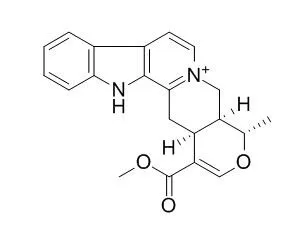| Description: |
Alstonine is an indole alkaloid that has an antipsychotic activity, by decreasing glutamate uptake and using the step-down inhibitory avoidance paradigm and MK801-induced working memory deficits in mice. Alstonine prevents the expected fasting-induced decrease in glucose levels. |
| Targets: |
Dopamine Receptor | 5-HT Receptor |
| In vitro: |
| Neurochem Int. 2012 Dec;61(7):1144-50. | | Effects of the putative antipsychotic alstonine on glutamate uptake in acute hippocampal slices.[Pubmed: 22940693] | A dysfunctional glutamatergic system is thought to be central to the negative symptoms and cognitive deficits recognized as determinant to the poor quality of life of people with schizophrenia. Modulating glutamate uptake has, thus, been suggested as a novel target for antipsychotics. Alstonine is an indole alkaloid sharing with atypical antipsychotics the profile in animal models relevant to schizophrenia, though divergent in its mechanism of action. The aim of this study was to evaluate the effects of Alstonine on glutamate uptake.
Additionally, the effects on glutathione content and extracellular S100B levels were assessed.
METHODS AND RESULTS:
Acute hippocampal slices were incubated with haloperidol (10μM), clozapine (10 and 100μM) or Alstonine (1-100μM), alone or in combination with apomorphine (100μM), and 5-HT(2) receptor antagonists (0.01μM altanserin and 0.1μM SB 242084). A reduction in glutamate uptake was observed with Alstonine and clozapine, but not haloperidol. Apomorphine abolished the effect of clozapine, whereas 5-HT(2A) and 5-HT(2C) antagonists abolished the effects of Alstonine. Increased levels of glutathione were observed only with Alstonine, also the only compound that failed to decrease the release of S100B. This study shows that Alstonine decreases glutamate uptake, which may be beneficial to the glutamatergic deficit observed in schizophrenia. Noteworthily, the decrease in glutamate uptake is compatible with the reversal of MK-801-induced social interaction and working memory deficits. An additional potential benefit of
CONCLUSIONS:
Alstonine as an antipsychotic is its ability to increase glutathione, a key cellular antioxidant reported to be decreased in the brain of patients with schizophrenia. Adding to the characterization of the novel mechanism of action of Alstonine, the lack of effect of apomorphine in Alstonine-induced changes in glutamate uptake reinforces that D(2) receptors are not primarily implicated. Though clearly mediated by 5-HT(2A) and 5-HT(2C) serotonin receptors, the precise mechanisms that result in the effects of Alstonine on glutamate uptake warrant elucidation. |
|
| In vivo: |
| Phytomedicine. 2015 Jan 15;22(1):52-5. | | Original mechanisms of antipsychotic action by the indole alkaloid alstonine(Picralima nitida).[Pubmed: 25636871] |
Alstonine is the major component of plant based remedies that traditional psychiatrists use in Nigeria. Alstonine is an indole alkaloid that has an antipsychotic experimental profile comparable with that of clozapine and is compatible with the alleged effects in mental patients. Representing a desirable innovation in the pharmacodynamics of antipsychotic medications, the evidence indicates that Alstonine does not bind to D2 dopamine receptors (D2R) and differentially regulates dopamine in the cortical and limbic areas.
METHODS AND RESULTS:
The purpose of this study was to further investigate the effects of Alstonine on D2R binding in specific brain regions using quantitative autoradiography (QAR) and its effects on dopamine (DA) uptake in mouse striatal synaptosomes. The effects of Alstonine on D2R binding were determined in the nucleus accumbens and caudate-putamen using QAR in mice treated with Alstonine doses that have antipsychotic effects. The effects of Alstonine [3H]DA uptake were assessed in synaptosomes prepared from striatal tissue obtained from mice treated acutely or for 7 days with Alstonine. Alstonine did not change the D2R binding densities in the studied regions. DA uptake was increased after acute (but not after 7 days) treatment with Alstonine.
CONCLUSIONS:
Consistent with the Alstonine behavioral profile, these results indicate that Alstonine indirectly modulates DA receptors, specifically by modulating DA uptake. This unique mechanism for DA transmission modulation contributes to the antipsychotic-like effects of Alstonine and is compatible with its behavioral profile in mice and alleged effects in patients. These results may represent an innovation in the antipsychotic development field. | | Evid Based Complement Alternat Med. 2011;2011:418597. | | Alstonine as an antipsychotic: effects on brain amines and metabolic changes.[Pubmed: 19189988] | Managing schizophrenia has never been a trivial matter. Furthermore, while classical antipsychotics induce extrapyramidal side effects and hyperprolactinaemia, atypical antipsychotics lead to diabetes, hyperlipidaemia, and weight gain. Moreover, even with newer drugs, a sizable proportion of patients do not show significant improvement. Alstonine is an indole alkaloid identified as the major component of a plant-based remedy used in Nigeria to treat the mentally ill. Alstonine presents a clear antipsychotic profile in rodents, apparently with differential effects in distinct dopaminergic pathways.
METHODS AND RESULTS:
The aim of this study was to complement the antipsychotic profile of Alstonine, verifying its effects on brain amines in mouse frontal cortex and striatum. Additionally, we examined if Alstonine induces some hormonal and metabolic changes common to antipsychotics. HPLC data reveal that Alstonine increases serotonergic transmission and increases intraneuronal dopamine catabolism. In relation to possible side effects, preliminary data suggest that Alstonine does not affect prolactin levels, does not induce gains in body weight, but prevents the expected fasting-induced decrease in glucose levels.
CONCLUSIONS:
Overall, this study reinforces the proposal that Alstonine is a potential innovative antipsychotic, and that a comprehensive understanding of its neurochemical basis may open new avenues to developing newer antipsychotic medications. |
|






 Cell. 2018 Jan 11;172(1-2):249-261.e12. doi: 10.1016/j.cell.2017.12.019.IF=36.216(2019)
Cell. 2018 Jan 11;172(1-2):249-261.e12. doi: 10.1016/j.cell.2017.12.019.IF=36.216(2019) Cell Metab. 2020 Mar 3;31(3):534-548.e5. doi: 10.1016/j.cmet.2020.01.002.IF=22.415(2019)
Cell Metab. 2020 Mar 3;31(3):534-548.e5. doi: 10.1016/j.cmet.2020.01.002.IF=22.415(2019) Mol Cell. 2017 Nov 16;68(4):673-685.e6. doi: 10.1016/j.molcel.2017.10.022.IF=14.548(2019)
Mol Cell. 2017 Nov 16;68(4):673-685.e6. doi: 10.1016/j.molcel.2017.10.022.IF=14.548(2019)